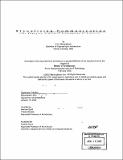Visualizing communication : the changing medium of information in library
Author(s)
Kim, Myoungkeun, 1973-
DownloadFull printable version (22.06Mb)
Other Contributors
Massachusetts Institute of Technology. Dept. of Architecture.
Advisor
Andrew Scott.
Terms of use
Metadata
Show full item recordAbstract
In the area of normal language, there is a ground language that makes abstract language possible. Likewise, the hypothesis in this project is that there are two systems of language in architecture. The language that has been employed in architecture most commonly has been abstract and undecipherable. It is one-way communication: information flows from architects to architecture, but not to users. However, if the notion of language is considered as a communicative tool, likewise architectural languages should embody two-way communication. But because in architecture there is no verbal equivalent of a ground language that makes abstract meaning possible, the language of my project must be visual and intuitive. I believe this direct visual language is the ground language in architecture. By visualizing the mechanisms of architecture, users would know what architecture is saying and might have opportunities to talk about it and actively participate in it. In this research, the mechanism of architecture to be communicated is the event taking place within the library itself: namely, it's own transition from the real to the virtual. A series of diagrams were generated at the beginning of project to understand library programs ever-changing along the development of technology. The overall process of this project consists of dominant two stages. The first stage is about hardware of building: structure, and the second stage is about software: SpaceModulator. At the fist stage, several building configurations were examined to maximize the impact of the visualization. The idea of flexibility was introduced to respond to the current issue of the library's "changing medium". At the second stage, SpatialModulators that control the overall architectural quality were generated. These include furniture and adjustable walls. These discreet objects are meant to reflect the over-arching ideas of the thesis: that is, to illustrate the inner condition of the library and describe the events in the "urban book shelf".
Description
Thesis (M.Arch.)--Massachusetts Institute of Technology, Dept. of Architecture, 2002. Some ill. folded. Includes bibliographical references (p. 75).
Date issued
2002Department
Massachusetts Institute of Technology. Department of ArchitecturePublisher
Massachusetts Institute of Technology
Keywords
Architecture.